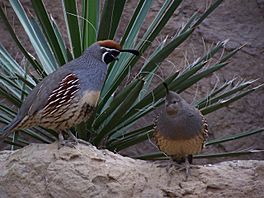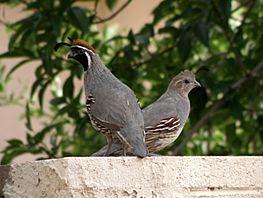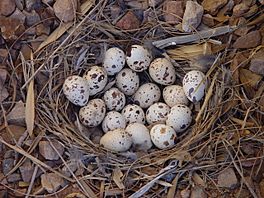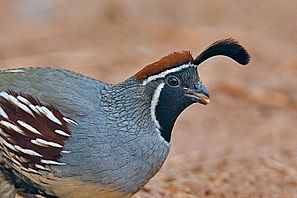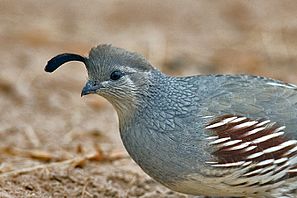Gambel's quail facts for kids
Quick facts for kids Gambel's quail |
|
|---|---|
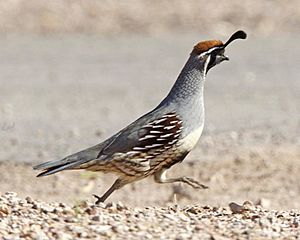 |
|
| Male Gambel's quail in Las Vegas, Nevada | |
| Conservation status | |
| Scientific classification | |
| Genus: |
Callipepla
|
| Species: |
gambelii
|
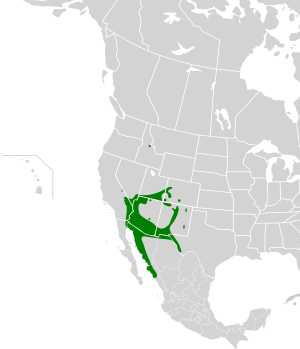 |
|
The Gambel's quail (Callipepla gambelii) is a small bird. It lives on the ground in desert areas. You can find it in the southwestern United States and parts of Mexico. These areas include Arizona, California, Nevada, and Sonora. The bird is named after William Gambel. He was a naturalist and explorer in the 1800s.
Gambel's quail are not found in as many places as the California quail. However, some were brought to San Clemente Island in 1912. They still live there today.
Contents
What Gambel's Quail Look Like
Gambel's quail are easy to spot. They have a cool "top knot" on their heads. This is a plume of feathers that points forward. Their bellies have a scaly pattern.
Most of their body feathers are bluish-gray. Male quails have copper-colored feathers on their heads. They also have black faces and white stripes above their eyes. These birds are about 11 inches (28 cm) long. Their wingspan is usually 14 to 16 inches (36–41 cm). They have short, rounded wings. Their legs are long and do not have feathers.
How to Tell Them Apart from California Quail
Gambel's quail can look a lot like California quail. You can often tell them apart by where they live. If they live in the same area, look closely. California quail have more scales on their feathers. Male Gambel's quail have a black patch on their lower chest. This patch is missing on California quail. These two types of quail are very closely related. They separated into different species about 1 to 2 million years ago.
Gambel's Quail Behavior and Life Cycle
Gambel's quail mostly move around by walking. They can walk very fast through bushes and plants. They do not migrate, meaning they stay in the same area all year. You will rarely see them flying. When they do fly, it's usually a short, fast burst. They flap their wings many times quickly. Then they glide slowly back to the ground.
Social Life and Family
In late summer, fall, and winter, these birds gather in large groups. These groups are called "coveys." In the spring, Gambel's quail find a partner for mating. They become very protective of their territory. They will act aggressively toward other quail pairs.
Gambel's quail are monogamous. This means they usually have only one partner. They rarely nest close to other quail pairs. The female usually lays 10 to 12 eggs. She makes a simple nest on the ground. It is often hidden under plants, rocks, or trees.
Eggs and Chicks
The female usually sits on the eggs for 21 to 23 days. This is called incubation. The male rarely helps with this. The chicks are born ready to move. They leave the nest with their parents just hours after hatching. When they are very young, chicks eat mostly insects. As they grow older, they start to eat more plants.
What Gambel's Quail Eat
Gambel's quail eat insects, especially in the summer. They also eat many different kinds of plants and seeds. Unlike some other birds, they need a lot of protein in their diet.
Gallery
-
A pair at Indianapolis Zoo (male on left and female on right)
- Interactive range map of Callipepla gambelii at IUCN Red List maps
See also
 In Spanish: Colín de Gambel para niños
In Spanish: Colín de Gambel para niños



